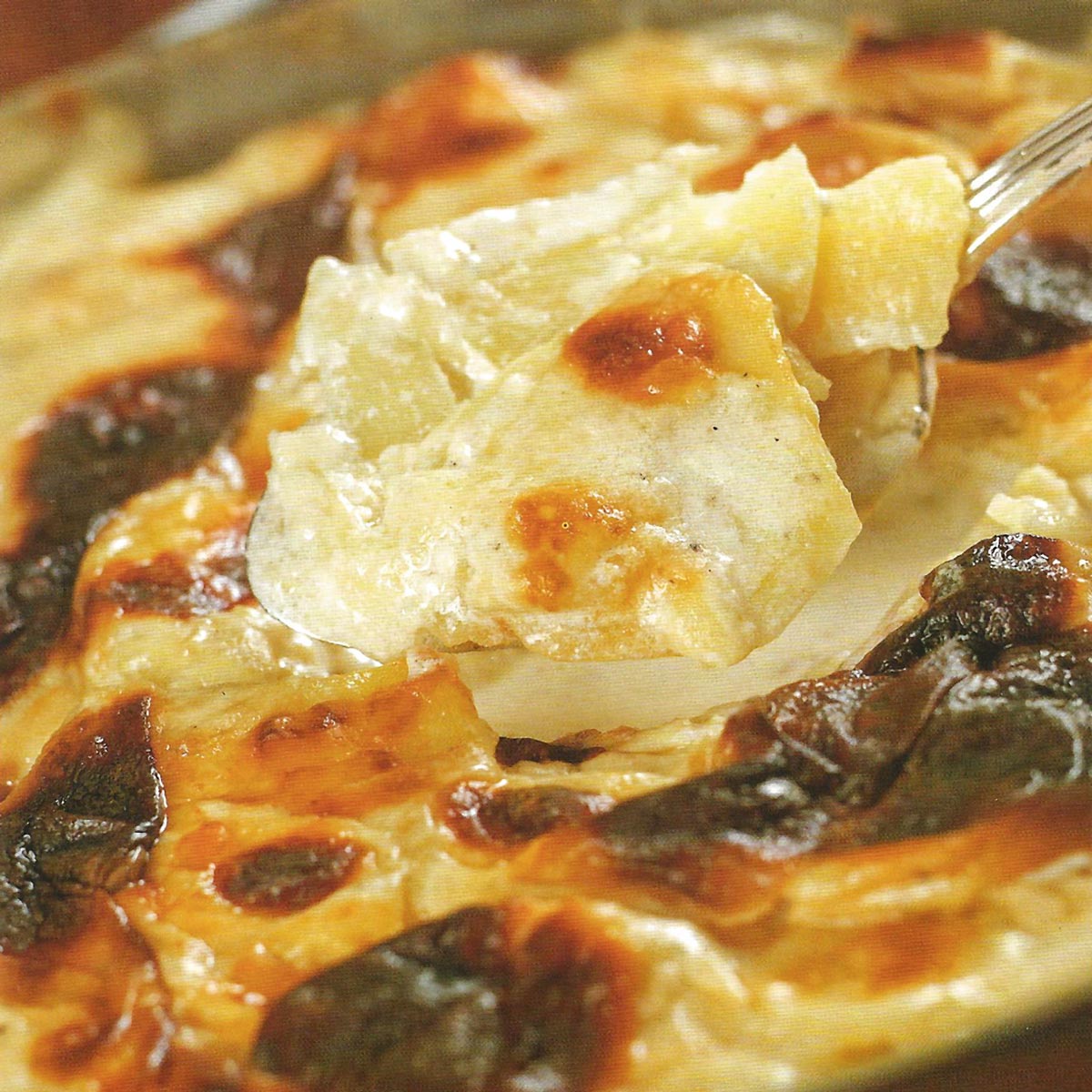
Tom Hopkins
Gratin Dauphinois
Yield: 6 Servings
About
A seminal dish for me is gratin dauphinois, which consists of thinly sliced potatoes that are combined with milk, cream, garlic, salt, and pepper, brought to a boil on top of the stove, and transformed into a glorious golden gratin with a cheese crust.
The gratins I enjoyed as a child came from my two aunts, my cousin Merret, and my mother. All of these formidable women prepared gratin dauphinois, with various taste results, but I loved different things about most of them: the simplicity of my mother’s; the richness of my Aunt Hélène’s; the finesse of Merret’s. But it was the gratin from Tante Aimée, from Valence, that was my favorite-I am not sure why. She would serve it with veal roast, which was perfect with it.
Dauphinois defines an area of France around Grenoble, the town at the bottom of the Alps. This gratin is a specialty of the area, and it is considered an abomination to put cheese on top. Yet, in other parts of France, Lyon for example, people do top the potatoes with cheese. My mother always put Gruyère on top and made the dish entirely with milk. In many of the Michelin 3 – star restaurants-from Troisgros, near Grenoble, to Bocuse in Lyon-it is usually prepared with heavy cream rather than milk, and no cheese. Subsequently, it glazes beautifully. My mother’s gratin would not have glazed as well, so she topped it with grated Swiss cheese for the look as well as for the taste.
I have had gratin dauphinois with eggs in it, and with precooked potatoes, neither to my liking. I do not like it prepared just with heavy cream-it is much too rich-or just with milk, which makes it too lean. I recommend a mixture of milk and cream; about 2½ cups of milk for 1 cup of heavy cream gives a beautiful result. In this recipe, I use half- and-half, which works out to be about the same ratio you would achieve if you used part milk and part cream.
The good thing about gratin dauphinois is that leftovers are great the day after. When I was a kid, there was often a big gratin dauphinois my mother prepared for special family dinners. Since we had no refrigerator, the leftover gratin was kept in the cellar overnight with a towel on top to keep the flies away. The following day, it was a special lunch for my father. The leftover gratin had to be at room temperature and served with a salad of curly endive tossed with a dressing of garlic, mustard, salt, pepper, red wine vinegar, and peanut oil. I have come to love my gratins the day after as much as my father did. The room-temperature dauphinois is served on the same plate with the cool (but not cold) salad and a glass of Côtes du Rhône or Zinfandel. Lunch usually finishes with a piece of goat cheese or a wedge of Reblochon cheese, from the Savoie.
The potatoes are very important in the gratin dauphinois. Boiling potatoes, like Red Bliss, are my favorite choice for this dish. It is essential to peel the potatoes, rinse them under cool water, and then cover them with water. This much can be done the day before and the potatoes refrigerated in the water. Be certain they are totally submerged in the water, as any areas not submerged will discolor.
It is anathema to slice the potatoes ahead and wash the slices. When potato slices are washed, they release some of their starch, which is needed for the texture of the gratin dauphinois, and the gratin doesn’t have the glossy, silky texture that it should have. If you are very proficient with a knife, cut the peeled and washed potatoes thinly into slices about ⅛-inch thick. If not, use a food processor with a slicing blade or a mandoline to slice the potatoes.
This dish is excellent with roast chicken, roasted veal, or grilled leg of lamb. Make certain that you save enough to enjoy the following day with garlicky salad for lunch, just like my father did and just like I do each time I prepare gratin dauphinois.
Recipe
- For six people, slice about 2 POUNDS OF PEELED POTATOES, and put them in a large saucepan (do not wash the slices). Add about 1 QUART OF HALF-AND-HALF, 1/2 TEASPOONS OF FINELY CHOPPED GARLIC, a good amount of GROUND BLACK PEPPERCORNS (although Julia would have preferred white!), and SALT. Mix together, and bring the mixture to a boil on top of the stove. Make sure to stir it well with a wooden spatula to separate the slices of potato, which tend to stick together. As the mixture comes to a boil, scrape the bottom of the saucepan to prevent the potatoes from sticking to it. When it gets close to the boil, the mixture will thicken and get creamy.
- Let the potatoes bubble for a minute or so, and then pour them into a 6 to 8 cup buttered gratin dish. Sprinkle about ½ CUP OF FINELY GRATED SWISS CHEESE (Gruyère, Jarlsberg, or Emmenthaler) and 1 TABLESPOON OF GRATED PARMESAN CHEESE on top. Plan to bake the gratin far enough in advance so that it can sit for a while before serving, as it is too hot and bubbly when it emerges from the oven to be served right away.
- Preheat the oven to 400°F. Bake the gratin for about 1 hour. It should be beautifully glazed when ready. Let rest and cool for about 3o minutes before serving. If not ready to serve at this point, keep, uncovered, in a 160 to 170°F oven until serving time.
Recipe Source

Chez Jacques
Of the 20-plus cookbooks Jacques Pépin has written, Chez Jacques is his most personal and engaging. Now starring in his tenth PBS series, Pépin ranks among America’s most beloved cooking teachers, and this book shows us why.
Buy now